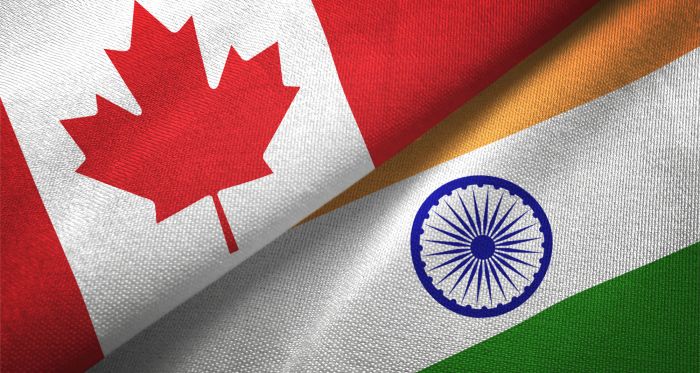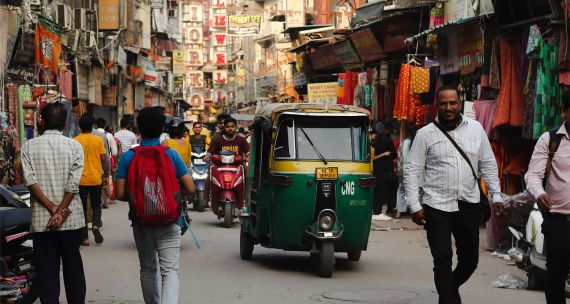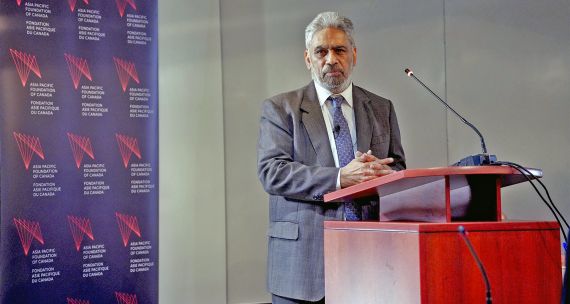While the Canada-India relationship started on a strong note in the 1940s and 1950s, characterized by a shared commitment to democracy and multilateralism, bilateral relations have faced historical roadblocks and mistrust. Although ties were elevated to a ‘strategic partnership’ in 2015, significant challenges prevent the two sides from fully realizing the relationship's potential amid escalating geopolitical and geo-economic uncertainties. While strategic partnerships between India — the world’s fastest-growing major economy, with 1.4 billion people, and a vital player in maintaining peace and security in the Indo-Pacific — and other Western nations such as Australia, the U.K., and the U.S. have strengthened, much remains to be done for Canada and India to build deeper, more resilient ties. There are significant opportunities to explore new areas of co-operation, building on existing partnerships and leveraging complementarities.
Current Challenges in the Canada-India Relations
A major source of strain in recent years has been the Khalistan movement and its supporters in Canada, who advocate for an independent Sikh state to be carved out of the Indian state of Punjab. This issue is perceived as a serious national security threat in India. In September 2023, following the murder of Khalistani activist Hardeep Singh Nijjar in Surrey, B.C., Canadian Prime Minister Justin Trudeau cited “credible allegations” that agents of the Indian state were implicit in Nijjar’s killing — a Canadian citizen on Canadian soil. This statement led to a subsequent deep freeze in bilateral relations. New Delhi denied these allegations and accused Canada of being a “safe haven” for extremist activities that threaten India’s sovereignty.
Similar allegations against the Indian government surfaced in November 2023 with the unsealing of an indictment in a New York court that linked an Indian government official to a foiled ‘murder-for-hire’ plot targeting a Khalistani activist on U.S. soil. In October 2024, the U.S. Department of Justice announced charges against this official, now identified as Vikash Yadav. While the indictment in the U.S. connected the alleged plot in the U.S. with the murder of Hardeep Singh Nijjar in Canada, New Delhi’s reaction to the two cases has been starkly different. A high-level inquiry into the U.S. court indictment was launched in India, with Indian officials probing the matter, whereas, in the Canadian case, the diplomatic row escalated.
In October 2024, the Royal Canadian Mounted Police and the Canadian government alleged that Indian diplomats in Canada were linked to violent crimes in India, including murder, extortion, and intimidation. This resulted in another round of mutual diplomatic expulsions, plunging bilateral relations to unprecedented lows. During this period, allegations of Indian electoral interference in Canada’s democratic system also surfaced.
On January 28, 2025, Commissioner Marie-Josée Hogue’s final report from Canada’s Public Inquiry into Foreign Interference in Federal Electoral Processes and Democratic Instituitions stated that India has become “the second most active country” after China in engaging in electoral foreign interference in Canada. The report also noted that “a body of intelligence indicates that proxy agents may have, and may continue to, clandestinely provide illicit financial support to various Canadian politicians in an attempt to secure the election of pro-India candidates or gain influence over candidates who take office.” The Indian Ministry of External Affairs rejected the report and its “insinuations.”
Bilateral Relations Over the Decades
After India’s independence, Canada played a significant role in providing foreign aid to India, particularly through the Colombo Plan. However, relations soured following India’s first nuclear test in 1974, which used plutonium from a Canadian-made research reactor. This event led to decades of sanctions and mistrust.
A major issue that continues to affect the relationship today began gaining attention in the 1980s: a violent secessionist movement in the Indian state of Punjab to create an independent Sikh homeland called Khalistan. While this movement has largely lost traction in India, it remains a point of tension due to India’s concerns over secessionist activism within Canada’s large Sikh diaspora. These tensions deepened in the 1980s following the bombing of Air India Flight 182 in 1985, which resulted in the deaths of 329 people, mostly Canadians of Indian origin.
The relationship suffered another setback in 1998 when India conducted its second nuclear test. In response, Canada imposed economic sanctions on India, including restrictions on nuclear and military trade, and cut certain development aid. Starting in 2001, these sanctions were gradually lifted as both nations worked to rebuild their relationship. Diplomatic relations reached a high point with the signing of the Nuclear Co-operation Agreement in 2010, marking a significant shift in Canada’s policy toward India under the Harper government. The agreement allowed Canada to export nuclear fuel to India, subject to strict safeguards.
In 2010, an independent public inquiry by retired Supreme Court of Canada Justice John C. Major found "error, incompetence, and inattention" by Canadian agencies at all stages of the 1985 Air India tragedy: before the bombings, in their aftermath, and during the subsequent investigation and legal proceedings. Shortly thereafter, Prime Minister Stephen Harper issued an apology for Canada’s official failings.
Economic Ties
While Ottawa recognized India’s immense potential in its 2022 Indo-Pacific Strategy, highlighting the South Asian nation’s "growing strategic, economic, and demographic importance in the Indo-Pacific,” there remains significant untapped potential in the bilateral economic relationship. That same year, India was Canada’s 10th largest trading partner. Historically, however, Canada’s share in India’s goods imports has been low, ranging from approximately 0.5 per cent to one per cent, while India's exports to Canada as a percentage of its total exports have also remained modest, fluctuating between one per cent and 1.5 per cent.
In 2023, Canada reported total merchandise trade with India of C$12.5 billion. Canada's exports to India were valued at C$5 billion, while imports from India amounted to C$7.5 billion, leading to a trade deficit for Canada of approximately C$2.5 billion. However, in services trade, Canada recorded a significant surplus of C$10.8 billion in 2023, marking a 90 per cent increase from C$5.7 billion in 2022. This was driven by C$14.06 billion in services exports — including travel, commercial, and transportation services — compared to C$3.22 billion in services imports.
In 2010, Canada and India initiated negotiations toward a Comprehensive Economic Partnership Agreement. Since March 2022, New Delhi and Ottawa moved toward negotiating a more limited agreement focusing on specific industries, known as the Early Progress Trade Agreement. In September 2023, shortly before Trudeau’s statement on the Nijjar killing, Ottawa paused negotiations on the free trade agreement.
Sectoral share in goods trade
In 2023, Canada’s merchandise exports to India were concentrated in a few key sectors, with the top 10 categories accounting for 85.3 per cent of total exports. The largest category was mineral fuels and oils, which made up 21.67 per cent of exports, followed by edible vegetables, roots, and tubers at 15.98 per cent, and fertilizers at 11.51 per cent.
India’s exports to Canada were more diversified, ranging from electrical machinery and equipment to pharmaceutical products, boilers, and mechanical appliances.
The higher education sector
International students’ tuition fees provide substantial funding to Canadian educational institutions. In 2022, international students contributed approximately C$31 billion to Canada’s GDP, accounting for 1.2 per cent of the total. Nearly all of this spending came from long-term students, with Indian students as the largest cohort accounting for 41 per cent of all international student permits issued in 2022 and 37 per cent by November 2023. Students from Punjab alone contributed US$8 billion to the Canadian economy in 2023. Several academic and research collaborations have also played a critical role in enhancing bilateral ties. The higher education sector, however, has come under severe strain due to changes in Canadian immigration policies in 2024 and the bilateral diplomatic crisis.
Canadian investments in India
As of September 2023, Canada ranked as the 17th-largest foreign investor in India, with cumulative foreign direct investment (FDI) totalling US$4.05 billion between April 2000 and September 2024. This represents 0.57 per cent of India’s total FDI inflows.
Notably, Canadian foreign institutional investment, such as by pension funds, mutual funds, and insurance companies, in India’s stock market, bonds, and other financial assets has experienced significant growth, rising from C$5 billion in 2014 to over C$55 billion as of October 2023. These investments span sectors such as infrastructure, including highways, airports, clean energy, education, logistics, real estate, banking, hospitality, and warehousing.
In 2024, the largest foreign direct investments (FDI), including by pension funds, from Canada to India were by the Ontario Teachers' Pension Plan Board, Canada Pension Plan Investment Board, Ivanhoe Cambridge, Brookfield Asset Management, and Fairfax India Holdings Corporation.
Canadian Pension Fund investments in India:
- As Canadian pension funds moved away from China, India emerged as a key investment destination. Between 2019-23, 25 per cent of Canadian pension fund flows went to India, an increase from 10 per cent during the 2003-18 period.
- Between 2013-23, 57 per cent of Canadian pension funds' investments in India were in real estate, financial services, and industrial transportation, with total investments over C$9.4 billion in these sectors.
- Despite bilateral tensions between Canada and India in September 2023, Canadian pension fund investments continued to grow. Investment flows increased from C$28 million in the third quarter of 2023 to C$111 million in the fourth quarter, largely driven by a major investment in Xpressbees by the Ontario Teachers’ Pension Plan Board.
Indian investments in Canada
In 2023, foreign direct investment by India in Canada stood at C$9.8 billion.
Canadian business presence in India
Over 1,000 Canadian companies are actively operating in India across sectors like IT, engineering, aviation, pharmaceuticals, banking, and consulting services. Major Canadian companies in India include SNC Lavalin, Bombardier, CAE Electronics, Sun Life, MDS Nordion, Amdocs, and McCain Foods.
Indian business presence in Canada
The estimated number of Indian-headquartered companies present in Canada is between 75 and 80. Thirty India-based companies invested sums exceeding C$6.6 billion and created nearly 17,000 jobs across Canada, according to a survey report released in May 2023 by the Confederation of Indian Industry in partnership with the Canada India Business Council and the High Commission of India in Canada.
Major Indian companies in Canada include the Aditya Birla Group, Tata Steel, Essar Steel, Jubilant Life Sciences, Tata Consultancy Services, Mahindra Satyam, Polaris Financial Technologies, WIPRO, and Infosys. State Bank of India and ICICI banks have nine and seven branches in Canada, respectively.
Which sectors have potential for growth?
For Canadian businesses and investors in India, there remains a huge potential in key sectors, including infrastructure, agriculture, clean energy, critical minerals, and advanced manufacturing. For specific products, such as gold-unwrought, potassium chloride as fertilizer, and lentils, export potential remains high.
For Indian investors and businesses looking toward Canada, there is greater potential in information technology, natural resources, financial services, and the pharmaceuticals sector. For exporters, the products with the greatest export potential from India to Canada are medicaments, motor vehicles, mobile phones, shrimp, rice, and precious metals.
India supports Canada’s economic security needs by providing avenues for diversifying trade, enhancing supply chain resilience, and fostering strategic partnerships in technology and clean energy. Investments and shared resources will further strengthen economic stability.
Which sectors have been affected by diplomatic tensions since 2023?
Most impacted: Tourism, investments, and potentially higher education.
- In September 2023, India suspended visas to Canadian citizens amid an escalating row over the killing of a Khalistani activist on Canadian soil, leading to a reduction in Canadian tourists to India. While the visa suspension was temporary, this resulted in disruptions and a loss of income for the Indian tourism sector.
- There was a drop in FDI from Canada to India, decreasing from C$5.3 billion in 2022 to C$3.9 billion in 2023. However, India’s overall inflow of FDI — encompassing investments from all foreign sources — also declined by 47 per cent during the same period. Therefore, it is difficult to fully determine the extent to which bilateral tensions contributed to the reduction in Canadian investments in India.
- There was a drop in FDI from Canada to India, decreasing from C$5.3 billion in 2022 to C$3.9 billion in 2023. However, India’s overall inflow of FDI — encompassing investments from all foreign sources — also declined by 47 per cent during the same period. Therefore, it is difficult to fully determine the extent to which bilateral tensions contributed to the reduction in Canadian investments in India.
Minimal impact (so far): Trade.
Contrary to most expectations, two-way trade between Canada and India has seen an increase, with annual goods trade rising from C$12.6 billion in 2023 to C$13.3 billion in 2024. Notably, when comparing two-way trade figures from before the diplomatic standoff — such as in March 2023, when it totaled C$1.14 billion — the trade volume has remained relatively steady and even slightly higher in the months following the onset of the standoff, reaching C$1.17 billion in September 2024 and C$1.3 billion in October 2024.
Throughout 2023, Canada’s exports to India displayed greater stability compared to its imports, despite the lack of exclusive rights to export any particular commodity to the Indian market. Interestingly, Canada’s lentil exporters have urged the federal government to revive trade negotiations with India. As the supplier of over half of India’s lentil imports, Canada has maintained significant export levels despite the chill in bilateral diplomatic relations.
Potential risks: Higher education
Recent shifts in immigration trends highlight emerging challenges in the Canada-India relationship. Many Indians are returning from Canada due to high living costs and shrinking job opportunities. In addition, Indian applications for study permits saw a 40 per cent decline in 2023, driven by diplomatic tensions, Canadian immigration policy changes, and economic concerns. Further compounding the challenges, Canada announced plans to reduce student visas by 35 per cent in 2024, with an additional 10 per cent reduction planned for 2025, which is expected to significantly affect future international student intakes and the broader landscape of educational and economic ties between the two countries.
Co-operation in Defence, Security, Climate, and other Challenges
There remains significant untapped potential between Canada and India in the areas of defence and security. While both countries were strong advocates of multilateralism under the UN system in the 20th century, their defence and security partnerships have not been fully solidified in the 21st century. Despite shared values and interests, such as promoting a free and open Indo-Pacific and a rules-based international order, Canada is not part of any of the 'mini-lateral' groupings to which India belongs in the Indo-Pacific region.
Bilateral co-operation mechanisms
Canada and India share several bilateral mechanisms to address shared strategic and security priorities. Ministerial-level dialogues cover areas such as trade and energy co-operation. The defence ministers of both countries opened new avenues for collaboration in April 2023 as Indian Minister of Defence Rajnath Singh invited Canadian investments in India's defence sector and co-production ventures.
Joint working groups (JWGs) on specific sectors, such as the environment and counterterrorism, have enabled targeted co-operation. For instance, in 1997 the Joint Working Group on Counter-Terrorism was established, followed by a memorandum of understanding between India's Defence Research and Development Organisation and the Canadian Commercial Corporation in 2016 to focus on military technology, infrastructure, and training. This agreement was renewed in 2021. In 2018 the two countries signed a Framework for Co-operation on Countering Terrorism and Violent Extremism.
In June 2022, Ottawa and New Delhi signed an MOU to strengthen co-operation on global challenges such as environmental protection, climate action, and security. Both countries are also active members of the High Ambition Coalition for Nature and People, advocating for the conservation of 30 per cent of marine and terrestrial areas by 2030. The Ministerial-Level Energy Dialogue, initiated in 2016, was expanded during Trudeau’s visit to India in 2018, covering electricity, energy efficiency, and renewable energy.
The two countries have also forged a partnership in space through collaborations between Indian Space Research Organization (ISRO) and the Canadian Space Agency. Notably, Canada’s first Low Earth Orbit (LEO) satellite was launched on ISRO’s 100th Polar Satellite Launch Vehicle mission in January 2018. ANTRIX, the commercial arm of ISRO, has launched several nanosatellites from Canada. Both countries are signatories to the Artemis Accords, a non-binding set of principles designed to guide civil space exploration and use in the 21st century.
Several bilateral MOUs in recent years have strengthened co-operation in science, technology, and innovation, and have promoted knowledge exchange and research on the Arctic. Joint initiatives such as IC-IMPACTS and Mission Innovation, a multinational initiative to combat climate change, demonstrate the potential for collaboration in areas such as health care, waste management, and sustainability.
Multilateral engagements
Canada and India’s multilateral engagements underscore their common interests in promoting regional and global security as both countries are proponents of multilateralism and a rules-based order. Despite the outbreak of bilateral diplomatic tensions, Canada participated in the Indo-Pacific Armies Chiefs Conference in New Delhi in September 2023, highlighting shared strategic goals and priorities, especially in the Indo-Pacific region where Beijing’s rising assertiveness has raised shared concerns. Earlier in 2021, Canada participated in the QUAD joint naval exercise 'Sea Dragon.' In February 2024, the Canadian Armed Forces participated as an observer in the Milan exercise, a multilateral naval exercise hosted by the Indian navy, showcasing a shared commitment to maritime co-operation in the Indo-Pacific.
Defence trade
Although defence trade between Canada and India remains limited, the Indian Army was reportedly planning to procure Stryker armoured vehicles from an Ontario-based manufacturer, General Dynamics Land Systems Canada, for deployment in forward positions, particularly along its de facto border with China. However, progress on the deal has been stalled due to the ongoing diplomatic tensions between India and Canada.
Nuclear energy
Canada and India have a long history dating back to the 1950s on nuclear co-operation when Canada provided India with a research reactor for the latter’s nascent nuclear program. However, India’s first nuclear test in 1974 using the Canadian reactor shocked Ottawa and restricted nuclear co-operation. New Delhi’s second nuclear test in 1998 led to Canadian economic sanctions and restrictions on military ties with India. Nevertheless, the Nuclear Cooperation Agreement, signed in June 2010 and operational since September 2013, brought nuclear co-operation back on track and marked a significant milestone in the relationship. This agreement facilitated uranium supply to India through a partnership between India’s Department of Atomic Energy and Cameco Inc. In 2015, the Indian and Canadian governments signed this significant uranium supply deal, valued at C$350 million.
Views on major international conflicts
Canada and India’s responses to major international conflicts reflect their specific geopolitical interests. While Canada has strongly condemned Russia’s 2022 invasion of Ukraine, provided aid to Ukraine, and sanctioned the Russian regime like other Western nations, India has emphasized a diplomatic and peaceful resolution of the conflict without specifically condemning Russia. India also continues to purchase Russian crude oil at discounted prices.
In the Middle East, Canada’s support for a ‘two-state solution’ and condemnation of terrorism align with its commitment to human rights. India too has a longstanding commitment to a two-state solution and peace and security in the Middle East. While New Delhi has enduring ties with Palestine, in recent years it has also forged close relations with Israel.
On tensions around Taiwan and the South China Sea, Canada advocates for international law, freedom of navigation and overflight, and expresses concerns about China’s increasingly assertive activities. New Delhi, while supporting international law and freedom of navigation in the seas, shares a complex relationship with Beijing, marked by regional rivalry for influence as well as the need to manage tensions along their 4,000-kilometre-long disputed border.
Development Assistance to India
Ottawa ended its bilateral development assistance program in India in 2006 after 55 years and C$2.39 billion in aid, following a shift in New Delhi’s policy of receiving aid. Canada continues to provide support through Indian and Canadian NGOs and multilateral channels like the World Bank and the Asian Development Bank. Canada’s funding primarily focuses on sustainable economic development, the treatment of infectious diseases, nutrition, and renewable energy projects in vulnerable communities.
Canada’s International Development Research Centre has a regional office for Asia based in India and continues to support local institutions and academia in the country to generate research on climate change, expanding economic opportunities for workers, and advancing gender equality.
People-to-People Relations
The Indo-Canadian diaspora forms a critical link between Canada and India, with nearly 1.3 million Canadians of Indian heritage, accounting for nearly four per cent of Canada’s population. This vibrant community is concentrated in major urban centres such as Toronto, Vancouver, Montreal, Calgary, Edmonton, Ottawa, and Winnipeg, playing a vital role in enhancing cultural and economic ties.
Additionally, the presence of approximately 427,000 Indian students studying in Canada underscores the deep educational and cultural exchanges between the two nations. Institutions such as the Shastri Indo-Canadian Institute, founded in 1968, cement collaboration with 156 Indian and 36 Canadian member institutions, promoting education, research, and cultural exchange.
Diaspora politics, however, has also been a source of tension between Ottawa and New Delhi, particularly over India’s concerns about Khalistani activism in Canada. The two nations perceive the threat differently, with New Delhi viewing it as a resurgent security issue, while Canadian law protects secessionist calls as free speech unless they cross into criminal activity. Although Canada affirms its respect for India’s territorial integrity, recent media reports, in both countries have raised concerns about Khalistani activism allegedly occurring on Canadian soil.
Conclusion
Canada-India ties have faced several challenges and missed opportunities for deeper co-operation; yet they are underpinned by numerous factors that make them natural partners — especially given their alignment of interests and values in fostering innovation, prosperity, and a free and open Indo-Pacific, particularly amid geopolitical volatilities. Moving forward, a clear roadmap is needed to foster resilience in the relationship despite these challenges.
• Edited by Vice-President Research & Strategy Vina Nadjibulla and Senior Editor Ted Fraser, APF Canada







